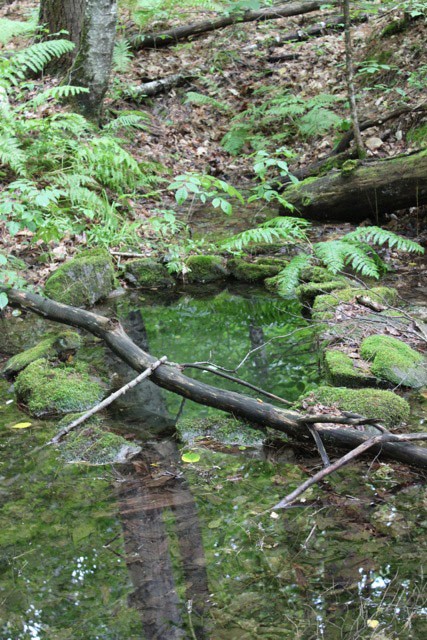Bella was first to find the old well. A border collie mutt with a heavy coat, she made it her business to sniff out water. On a hot day’s walk, she inserted herself tail first into its opening and rested there, paws crooked over the ring of rocks. I worried she was stuck and pulled her out. She rewarded me with one of her classic “humans are such dullards” expressions, then huffed off down the trail, a dignified exit compromised by her mud-daubed derriere.
Nine years have passed since that first discovery. Bella’s gone. I’m older. The well looks the same as it always has except, the rain falling so frequently this summer, it’s still in its vernal guise, submerged beneath a shallow pool. A ring of mossy stones surrounds a shallow hole, obscured by leaves and other gunk after the first couple of feet down.
Its location is peculiar. The well is on the side of the hill, a quarter of a mile or so above our old farm house. There’s no cellar hole or other evidence of a nearby dwelling. There’s likewise no record of a home site in the local history society’s records, although the town’s “poor farm,” the 19th century’s version of public assistance, was located down a nearby road.
I imagine other explanations. It isn’t a well at all but a holding tank for fish caught in the nearby river. It’s a portal, a mermaid’s bolt-hole, for those days when she’s tired of luring sailors to their doom and just wants to get away from it all in the woods.
According to Edna Feighner, an archaeologist at the New Hampshire Division of Historical Resources, the siting of old wells varies greatly, depending on the quirks of both water tables and well builders. She has found wells dug near and occasionally inside the foundations of old homes and barns, and also sited a distance, typically downhill, of structures. In a survey of a Keene, New Hampshire area property, she found many wells that were situated – like ours – on the slopes of hills. “These were probably for livestock,” she explains. Such wells might be left uncovered, to allow animals to self-water.
Whatever its initial purpose, the well – along with the stone walls straggling up through the trees - is a reminder that our woods is not pristine. It’s hard to imagine short cropped grass and sunwashed fields where now hardwoods grow in profusion, harder still to imagine what the land looked like circa 1800, when the massive beams and floorboards of our house were harvested. There’s an article in Northern Woodlands’ summer issue describing efforts to assemble evidence that shows what the Maine forest was like in the seventeenth century. It reveals how even in that wildest corner of New England, the appearance of contemporary forests is influenced by human decisions.



Discussion *